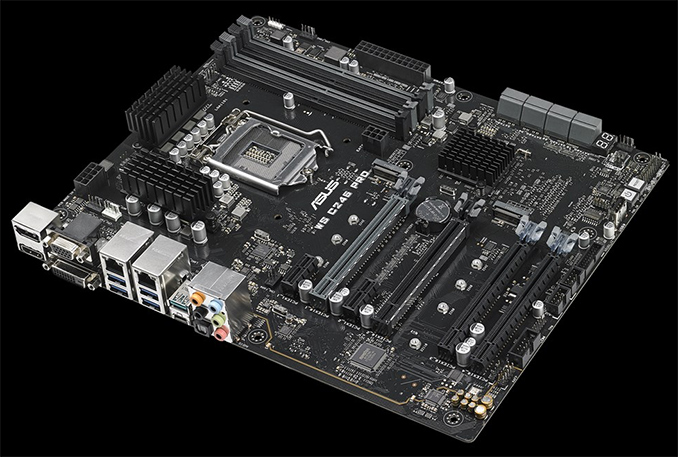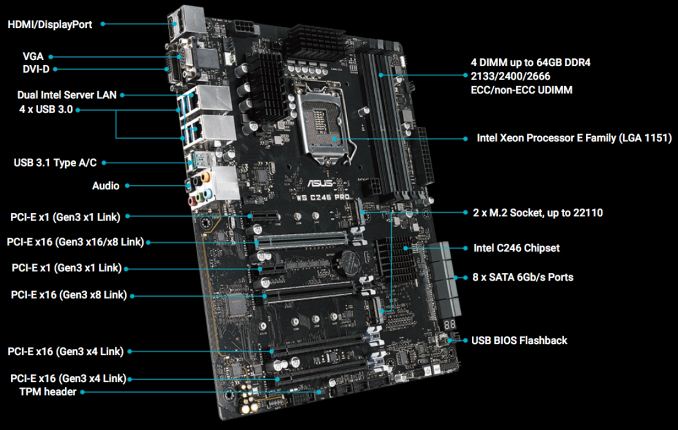ASUS Launches WS C246 PRO: 4 PCIe 3.0 x16, Two M.2, Optional SAS RAID
by Anton Shilov on July 27, 2018 1:00 PM EST- Posted in
- Motherboards
- Xeon
- Asus
- Servers
- Xeon E
- Intel C246

ASUS has introduced its first Intel C246-based motherboard for Intel’s Xeon E processors. The WS C246 PRO platform is aimed at rather serious machines that use up to four PCIe 3.0 x16 expansion cards, up to eight SATA storage devices, and two M.2 SSDs. For those who plan to use SAS storage with the motherboard, ASUS will also offer optional eight-port SAS 12G RAID cards.
The ASUS WS C246 PRO motherboard is based on Intel’s C246 chipset (codenamed Cannon Point-H WS) and therefore supports Intel’s Xeon E-2100-series processors for entry-level servers and workstations as well as Intel’s 8th Gen Core i3/i5/i7 chips along with their low-cost Pentium Gold and Celeron counterparts. The mainboard is outfitted with an eight-phase CPU VRM that uses solid-state inductors and capacitors to maintain steady operation during protracted workloads and also to ensure a long lifespan for the product. The WS C246 PRO is not equipped with a TPM module, but there is a connector for it, so workstation OEMs can install it themselves. As for remote management, the platform supports the WFM 2.0 spec as well as ASUS’ proprietary ACC IT management platform.
Memory support is something that all Intel C246-based motherboards are going to have in common. Just like the rest of the C246 pack, the WS C246 PRO has four DDR4 DIMM slots supporting up to 64 GB of DDR4-2667 DRAM with or without ECC, depending on the CPU and modules used.
Things start to get interesting with PCIe slots configuration of the WS C246 PRO. The motherboard has four PCIe 3.0 x16 (electrical) connectors that can work in x16/x8, x8, x4 and x4 modes (logical). The first two are controlled by the CPU, whereas the remaining two rely on the C246 PCH. One of the reasons why ASUS outfitted the motherboard with so many electrical PCIe 3.0 x16 slots is the fact that it will supply the motherboard with its PIKE II 3008-8i 8-port SAS 12G RAID or PIKE II 3108-8i 8-port SAS 12G HW RAID controllers to parties interested in using SAS storage devices. Both HBA cards use a PCIe 3.0 x8 interface, so Intel needed to ensure that there are enough slots not only for SAS controllers, but for whatever other cards a customer may need to use (a high-end PCIe SSD, for example). In addition to PCIe 3.0 x16 slots, there are also two PCIe 3.0 x1 slots.
Moving on to other storage capabilities of the WS C246 PRO. The motherboard comes with eight SATA connectors as well as two M.2 slots supporting an up to M.2-2280 and an up to M.2-22110 SSDs. ASUS does not detail how the latter work and share resources with PCIe slots as well as SATA ports, but keep in mind that C246 PCH only supports eight SATA ports in total.
When it comes to general I/O interfaces, the WS C246 PRO features a fairly standard set of connectors, including two GbE ports, four USB 3.1 Gen 1 Type-A headers (there are internal ones too), USB 3.1 Gen 2 Type-A & Type-C receptacles, four display outputs (DP, HDMI, DVI, D-Sub), 3.5-mm jacks for a 7.1-channel audio subsystem, and so on.
ASUS did not touch upon pricing details and availability timeframe of the WS C246 PRO motherboard in its announcement, but keeping in mind market specifics, expect the first workstations based on this platform to arrive in the coming months. As for pricing, this is a specialized premium product and will be priced accordingly, especially when bundled with SAS HBAs.
| ASUS Intel C246 ATX Motherboard | |||
| WS C246 PRO | |||
| Supported CPUs | LGA1151 v2 CPUs Xeon E 8th Gen Core i3/i5/i7, Pentium, Celeron |
||
| PCH | Intel C246 (Cannon Point-H WS) |
||
| Graphics | Intel UHD Graphics from CPU PCIe 3.0 x16 slot |
||
| Display Outputs | 1 × DisplayPort 1.2 1 × HDMI 2.0a 1 × DVI-D 1 × D-Sub |
||
| Memory | 4 × DDR4 DIMM Up to 64 GB of DDR4-2667 with or without ECC, depending on CPU |
||
| Slots for Add-In-Cards | Electrical | Logical | |
| 1 × PCIe 3.0 x16 1 × PCIe 3.0 x8 2 × PCIe 3.0 16 1 × PCIe 3.0 x1 |
x16/x8 x8 x4 x1 |
||
| Ethernet | LAN 1: Intel I219LM GbE PHY LAN 2: Intel I210AT GbE PHY |
||
| Storage | M.2 | 1 × M.2-22110 (PCIe 3.0 x4 or SATA?) 1 × M.2-2280 (PCIe 3.0 x4 or SATA?) |
|
| SATA | 8 × SATA 6 Gbps | ||
| SAS (Optional) |
ASUS PIKE II 3008-8i 8-port SAS 12G RAID ASUS PIKE II 3108-8i 8-port SAS 12G HW RAID |
||
| Audio | 7.1-channel audio with analog and S/P DIF outputs | ||
| USB | 4 × USB 3.1 Gen 1 Type-A 1 × USB 3.1 Gen 2 Type-A 1 × USB 3.1 Gen 2 Type-C |
||
| Serial Ports | 1 × internal COM port | ||
| Other I/O | 1 × TPM header 1 × internal USB 3.1 Gen 1 Type-A (for BIOS flashing) 2 × internal USB Type-A (for front panel) |
||
| Monitoring | CPU Temperature Fan RPM |
||
| Management | WfM 2.0, DMI 3.0, WOL by PME, WOR by PME, PXE | ||
| Additional Features | ASUS Control Center (ACC), an integrated IT management platform for remote monitoring, controlling, and updating ASUS commercial products (servers, workstations, etc). | ||
| Form-Factor | ATX (305 mm × 244 mm | 12" × 9.6") | ||
Related Reading:
Source: ASUS












19 Comments
View All Comments
rozquilla - Friday, July 27, 2018 - link
Great features, and sober design, wish there were more of this on the mainstream (non-workstation) side.PhrogChief - Friday, July 27, 2018 - link
Absolutely. Miss the days of beautiful engineering like this in the enthusiast space with their plus and deluxe models. I want THIS Mobo design with a z370 chipset.PeachNCream - Friday, July 27, 2018 - link
I agree. This is a decent looking motherboard and I think its a pity that the industry pivoted away from using similar designs for their enthusiast products.StrangerGuy - Monday, July 30, 2018 - link
We all know you can't game on a PC unless the components come with a zillion RGB leds, edgy XTREMEZ styling and GAMING painted everywhere and optional auto "QUICK AND EASY" auto OCing that overvolts everything nearly to the brink of electromigration for an insignificant +10% clocks.cdillon - Friday, July 27, 2018 - link
Why no NBASE-T or 10GBASE-T NICs? I would expect that kind of thing on new workstation-level products, especially since they're already available on other boards. At least there are enough PCIe slots that adding a 10G NIC isn't likely to be a problem.mooninite - Friday, July 27, 2018 - link
Exactly. It is 2018 and this is the latest high-end platform and NONE of the C246 boards have 10Gbit NICs. It's like Intel specifically told the manufactures to NOT ship 10Gb stuff. I'm waiting until a board has a pair.bolkhov - Friday, July 27, 2018 - link
Supermicro C246 lineup isn't unveiled completely yet; their own "C246 OS compatibility" page lists more mobos than officially announced. And names of another dozen are known for months, including 10GbE ones and one X11SCM-LN8F (8x 1GbE plus IPMI).Asus previously launched their server/ws mobos in several waves (this happened with P9D* and P10S*). So, probably more to come, including 10GbE, integrated SAS etc.
Samus - Friday, July 27, 2018 - link
Reminds me of my Asus X58 WS motherboard. No doubt it could be just as stable. The X58 continues running to this day, 10 years old, on an overclocked i7-920 with 12GB DDR3 and a few drives. Most stable system I’ve ever owned, possibly rivaling the 440BX, and Intek hasn’t made anything like it since. Until possibly now with C246.cbm80 - Friday, July 27, 2018 - link
Instead of VGA/DVI they should have put two more displayport outputs (for double or triple monitor setups).danielfranklin - Friday, July 27, 2018 - link
Im assuming this has the same DMI3.0 bandwidth issues as its sister desktop platform?What a waste of a great attempt. At the end of the day if you are serious about using any of these slots or M2 connectors you need to move up to something with more "real" PCIe lanes, not this bottlenecked face lane stuff...
Come one intel, Its come to throw us a bone here! You want to sell more Optane? Give us somewhere to put it!